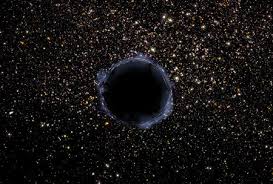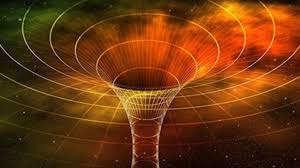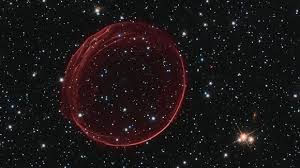THE TEN MOST INCREDIBLE THINGS ABOUT BLACK HOLES (I)
- planck
- Jul 27
- 6 min read
Black holes (BL) are, by far, the strangest and most fascinating real physical objects in the Universe. The laws of physics predict that these strange objects experience phenomena that completely defy the human brain's ability to visualize and understand. In this article, we'll explore ten of the strangest (and most unknown) phenomena surrounding these mysterious objects that populate our Universe.
1st) THE POSITION OF THE EVENT HORIZON DEPENDS ON THE FUTURE OF THE BLACK HOLE
The conventional image that practically everyone has of a black hole is that of a kind of cosmic "sink" that traps everything that crosses a certain "edge" called the event horizon. However, as we will see, this simple image is not entirely correct; in fact, even defining what a black hole is is not without its problems. In 1971, S. Hawking proposed the formal definition of the event horizon: it is defined as the limit of the causal past from the "future null infinity," that is, the "edge" that separates the region of space-time (the interior of the black hole) that is causally disconnected from the outside (where the outside includes not only space but also time). The problem with this definition is that real black holes are dynamic, that is, they evaporate over time until they disappear completely and to define the position of the event horizon at the current instant we would have to know the information of the "future null infinity", that is, the physical magnitudes of the NA (mass-energy, angular momentum and electric charge) of the entire future evolution of the NA, which is obviously impossible.
Another important problem when defining the "edge" of a NA is that there is no local physical experiment that can tell us the position of the event horizon. The event horizon is therefore a theoretical, acausal, and nonphysical boundary. To perform practical theoretical calculations on NA, other types of horizons are often used, such as "trapped horizons" or "apparent horizons," although these also involve problems arising from their definitions.
As if these problems didn't already complicate the description of a NA, there is another, even stranger and more spectacular complication: event horizons can occur even in flat spacetime. To see this, imagine a spherical mass of stardust whose mass is localized at the edge and which begins to collapse under the effect of gravity. Imagine that at time t0, a photon is emitted from the center of the collapsing mass. The photon expands outward while the mass collapses inward. If the photon reaches the edge at time t1 after the collapsing mass has reached the Schwarzschild radius, it will never be able to escape to the outside. This implies that at some point between t0 and t1, an event horizon has formed inside the sphere and that this horizon has expanded outward, even taking into account that there is no gravity inside the collapsing sphere (the collapsing mass is perfectly spherical) and therefore spacetime is flat. This phenomenon even opens the possibility that at this moment we are being crossed by an event horizon of enormous magnitude.
spherical mass that is collapsing from beyond our causal past, making this moment our last chance to send information to the outside.
All of this makes us wonder: What is a NA? How can we define a NA if we can't clearly define its border?

Schematic of a thin spherical shell of mass (black line) falling toward an already formed black hole (blue part). The event horizon (red line), by its very definition, is an acausal boundary that depends on the future of the NA and therefore begins to increase BEFORE the spherical mass enters the NA, anticipating the entry of matter into the NA. The so-called apparent horizons are local and respect causality but contain discontinuities (green line above the black line of the thin-mass shell).
2) BLACK HOLE RADIATION IS NOT PRODUCED ONLY FROM THE HORIZON
The famous physicist S. Hawking discovered that NAs emit radiation. The approximate image we all have of a process like this is that of a completely dark object emitting radiation from the event horizon. However, once again, this image is not entirely correct.
Quantum mechanics involves an intrinsic uncertainty about the exact position of the event horizon. Taking this fact into account, along with various relativistic effects, we find that, from the reference frame of an external observer, Hawking radiation is emitted from positions between 2Mlp2 and 3Mlp2, although it has a peak intensity near the horizon (position 2Mlp2). That is, the radiation is emitted within a region that can be quite far from the NA. It must be taken into account that Hawking radiation is an extremely slow process and has an enormous wavelength. This, combined with the uncertainty in the position from which it is emitted, makes this radiation almost impossible to detect. Furthermore, this radiation has another unusual characteristic: the emitted radiation quanta are quantumly entangled and are emitted in opposite directions. This means that while one member of the "entangled pair" escapes to the outside, the other crosses the horizon, disappearing completely from the "outside Universe." This phenomenon means that, from an external reference system , the AN produces and absorbs negative entropy.

3rd) THE EVENT HORIZON IS "MOVING AWAY" AT THE SPEED OF LIGHT
The "edge" of a NA, called the event horizon, is a surface with very strange characteristics. Seen from an external observer at rest, the event horizon recedes at the speed of light, that is, it is an unreachable surface, just as a ray of light is. If we saw an astronaut falling from this reference frame,
From the outside, we would see the same thing as if the astronaut were accelerating to almost the speed of light: the astronaut's time would seem to go slower and slower until it seemed to freeze at the edge. However, from the falling astronaut's frame of reference, everything proceeds normally; they could even cross the event horizon without seeing anything extraordinary. How is it possible to reconcile these two completely contradictory stories?
4th) THE BLACK HOLE IS A SUPERPOSITION OF DIFFERENT GEOMETRIES
When a BH is born, the uncertainty in its position and momentum is of the order of 2M; however, when a BH is old (near the end of the evaporation process), the uncertainty is of the order of M2. As the BH radiates energy, its geometry changes, so we can consider the BH as a quantum superposition of different geometries. Similarly to what happens with a quantum particle, it is not possible to locate the BH in a specific position; rather, it is a quantum system in superposition of an enormous number of possible geometries. This also implies another surprising fact: to describe the interior of a BH, we cannot use only the reference frame of an observer who falls towards the BH,
We need a whole set of reference frames for different observers at different points in time. We can then say that the interior of the NA is a superposition of different geometries defined at different points in time.
5th) THE AN STORES AN IMMENSE AMOUNT OF INFORMATION
At this point, we address one of the strangest (if possible) characteristics of NAs. The Bekenstein-Hawking expression tells us that a NA possesses kc3A/4hg different microstates. This represents an immense number of microstates, far more than any known object. Furthermore, this expression tells us that the microstates of a NA do not increase with the volume of the NA but only depend on the NA's surface area. How is this possible? If this is very strange in itself, the mystery increases when we consider that, according to general relativity, the NA is a very simple object with no internal structure: it is completely defined by just three physical quantities: mass, electric charge, and angular momentum. Is the NA a simple, structureless object, as general relativity tells us, or a highly complex object with an immense number of microstates, as quantum mechanics tells us? If the second option is correct, where is this immense amount of information stored?
As if this were not enough, there is another apparent paradox: from the point of view of an observer falling towards the NA, the object crosses the horizon without noticing anything strange, so the information about this object will remain forever within the NA. However, for an outside observer, the information about objects that have fallen into the NA is radiated outwards, which implies a shocking inconsistency. Where is the information really located? A possible explanation for these paradoxes will be given in the next section, in the second part of this article.









Comments